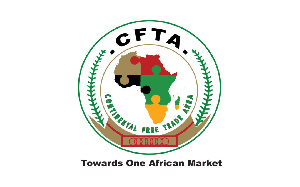Opinions of Monday, 16 September 2019
Columnist: Benjamin Avornyotse
An African trade dream in an era of Brexit?
The 18th Ordinary session, of Assembly of Heads of State and Government, in Addis Ababa, a zone for continental political resolutions this time, was no longer about an old cliché of ‘United Africa”.
In 2012, the leaders of the 54 African countries shifted the mandate of the founding fathers away from the dreams of a one Africa state under a single political umbrella to an integrated trade agreement dubbed “African Continental Free Trade Agreement’’(AFCFTA).
Fundamentally, the objective is to create a single market for goods and services and enhance a free movement of businesses and persons within the region.
Frankly, these objectives are good omen for the continent’s long awaited “UNITED AFRICA” dream. AFCFTA’s survival will largely depend on how the AU exercises its mandate as a regional body.
The framework, aimed at establishing an inclusive economic community for all African countries can only succeed in a peaceful environment divorced of oppression and needless political tensions. But most importantly, for the agreement to thrive, it will be primarily, dependent on the state parties and the Regional Economic Communities (REC).
The AU must create room to digest the basic concerns of its primary stakeholders. But how can we achieve this exceptional feat with xenophobic attacks still in major African economies like South Africa, Ghana, and the recent political uprising in Sudan, where citizens are yet to recover from political oppression and paramilitary brutality?.
Ethiopia is still brawled with old aged ethnic infighting, extending to higher political levels, leading to coup plots against political leaders in Africa’s second most populous nation. Instead of conflict-free democratic environment, a well regulated tariff regime, non-tariff barriers, flexible immigration policy, a continental custom union, fair gender representation, digital commerce and free press, the continent is yet to recover from predictable political menace.
There ought to be deliberate agenda of all trade ministers of state parties, RECs, third parties and most importantly itsrelationships with global trade organizations to see through the implementation of the trade agreement fully.
A continent with a soaring working-age population of about 705 million projected to hit 1 billion by 2030 with an average real GDP growth wavering around 4.0 in 2019 and expected to hit 4.1 by 2020, and to generate about 12 million jobs annually thus according to the African Development Bank’s 2019 Economic Outlook report.
This makes it more appealing with AFCFTA coming into force. This opens new market for transfer of goods and services, creating of value addition in manufacturing sector, allowing exchange of ideas and shared intellectual property among nations and citizens across the continent.
However, the crux of a single African market place, doesn’t lie in the choreographic display of voluminous documentation and fines speeches of African leaders and institutions, but must be backed by action and preparedness of it players.
Like every trade agreement, the responsibility lies with the key actors, to lift AFCFTA’s biggest hurdle by bringing all on board. Perhaps the most important will be Nigeria, which has taken a protectionist posture of shielding local manufacturers in its economy.
Nigeria is currently the most populous and largest economy on the African continent. But with the current 22 countries that ratified the agreement, should conceivably be a big boost for intra-African trade and position Africa as a major player in commerce, manufacturing and an investment destination.
Like the European Union’s current turf war with the U.K, African must survive the re-invented dream of its fathers, by building a robust economic community that is resistant to any form of a future“Afrixit”. Can Africa be different?
Entertainment










